Trapezius Muscle
The trapezius muscle is one of the major muscles of the upper back and neck region in humans. It is a large, triangular muscle that extends from the base of the skull, down the spine, and out to the shoulder blades. Its distinctive shape resembles a trapezoid, hence its name.
What Are The Trapezius Muscles?
Similar to a trapezoid, the trapezius muscle is a big superficial back muscle. It extends laterally to the scapula’s spine and from the occipital bone’s external protuberance to the lower thoracic vertebrae.
There are three fiber groups in the trapezius: upper, middle, and lower.
The motor function of the trapezius is innervated by the cranial nerve XI, which is the spinal accessory nerve.
The scapula is moved and stabilized by the trapezius muscle. The neck can be extended, and the upper fibers can rotate the scapula upward.
The scapula is adducted, or retracts, medially, by the middle fibers. To rotate the scapula upward, the lower fibers depress and assist the upper fibers.
Thanks to these movements, the scapula can spin in opposition to the rhomboid and levator scapulae muscles. Throwing objects requires this rotation in addition to the deltoid muscle.
Structure
The muscle that covers a significant portion of the upper back and is made up of exceptionally long muscle fibers is called the trapezius. In terms of functionality, this enables the trapezius to support and enable the erect posture of the spinal column when an individual is standing.
One of the largest and closest to the skin muscles in the upper back and trunk is the trapezius.
Since it is the first thing to be encountered when dissecting a cadaver, it is frequently utilized as a landmark. The trapezius is a large, slender muscle that forms a triangle and covers the neck and upper back of the shoulders.
The ligamentum nuchae, scapulae, clavicles, ribs, and the spinous process of the spine’s C7–T12 comprise its attachment points. The primary function of the trapezius muscle is postural, although it can also be employed for active motions such as head rotation, side bending, elevating and lowering the shoulders, and internal arm rotation. The scapula is raised, lowered, and retracted by the trapezius.
The arms are internally rotated by the descending muscular fibers of the trapezius muscle. The scapulae are retracted by the transverse muscle fibers and rotated medially by the ascending muscle fibers.
The trapezius muscle is thus composed of three halves. The superior part is attached to the neck (ligamentum nuchae) and skull(external occipital protuberance and superior nuchal line). The head is extended at the neck by this section of the muscle.
The central section connects to the upper region of C7-T12’s spinous processes. The two scapulae are drawn together (adducted) in this section. The scapula is depressed by the inferior section (lower segment of C7-T12). The acromion process, the lateral portion of the clavicle, and the scapular spine are the locations of muscle insertions.
The body wall and the arm are connected by the axio-appendicular muscles. The scapula is fixed so that the scapulohumeral muscles, which attach the scapula to the arm, can work properly. This is the true significance of the functions of the muscles that attach the body wall to the scapula.
The spinous process of C7, the external occipital protuberance, the medial third of the superior nuchal line of the occipital bone(all near the back of the head), and the ligamentum nuchae are the sources of the superior, or upper, fibers of the trapezius.
They emerge from this origin and go laterally and downward to enter the posterior border of the lateral third of the clavicle.
The spinous processes of the first, second, and third thoracic vertebrae as well as the seventh cervical spinous process (both in the back of the neck) are the sources of the middle fibers, also known as the transverse of the trapezius.
They are placed in the superior lip of the posterior border of the scapular spine and the medial margin of the acromion.
The spinous processes of the remaining thoracic vertebrae (T4–T12) are the source of the inferior or lower (or ascending) fibers of the trapezius. From this origin, they move laterally and upward, converging close to the scapula.
In the end, they form an aponeurosis, which glides over the medial end of the spine’s smooth triangular surface and inserts itself into a tubercle at the surface’s apex.
A thin fibrous lamina, firmly attached to the skin, connects the trapezius to the bone at its occipital origin. Both the sternocleidomastoid muscles and the investing deep fascia that surrounds the neck are continuous with the superficial and deep epimysia.
A large semi-elliptical aponeurosis, which extends from the sixth cervical to the third thoracic vertebrae, connects the muscle in its middle to the spinous processes.
Together with the opposing muscle, it creates a tendinous ellipse. A large number of short tendinous fibers give rise to the remaining muscle.
Grasping a weight in front of the body with one hand and using the other to touch the region between the neck and the shoulder will activate the superior trapezius muscles.
Function
The trapezius muscle serves as a muscle for movement as well as one for stabilizing posture. Imagine a big construction crane to get an idea of how the muscles in your back and upper limbs work.
The crane’s enormous arm is its most noticeable feature, but its stability depends on the jacks that fasten the cab to the ground. The upper limb, or the crane’s arm, would be useless without these muscles.
This big muscle facilitates proper posture and body movement. The trapezius is divided into three sections by medical professionals. Every section aids in a particular type of movement.
The three components of the trapezius work together to support head movement, upright posture, torso bending or twisting, and arm raising.
The trapezius’s regions are:
Upper trapezius
Your shoulder girdle can be raised or elevated by using your upper trapezius, the muscle that crosses the tops of your shoulders. Additionally, it aids with neck extension, tilting, and rotation, which helps spin and bring your head back. The rotation function moves the head to the side opposite the muscles in the neck and shoulders.
Although the upper trapezius muscle’s official activity is to elevate the shoulders, this isn’t necessarily a desirable thing. You probably already know this if your job requires you to drive a lot or if you work at a desk.
An ongoing, persistent pull on the shoulder girdle can cause misalignment and result in persistently tight upper traps. Pain, restricted mobility and a loss of neck flexibility could be the outcome.
The upper trapezius aids in rotating your shoulder blade upward together with the lower traps. If your muscles are flexible and your shoulders, neck, and upper back are in proper alignment, you can perform this movement by lifting your arm to the side.
The trapezius’s smallest segment is this one. It crosses the tops of your shoulders somewhat after beginning at the base of your neck. It helps you: Raise your arms.
Tilt, rotate, and stretch your head and neck.
Put your shoulders back.
Middle trapezius
The shoulder blades are assisted in returning toward the spine by the middle trapezius.
Once more, this may prove to be a useful move to prevent or manage excessive kyphotic (rounding of the upper back) posture in that area if you spend your days driving or sitting at a desk.
Additionally, the middle trapezius aids in shoulder stabilization during specific arm movements.
This muscle group is located directly beneath the upper trapezius. It spans the entirety of your shoulders. Middle traps are to blame for:
supporting you while you extend your arms behind you and retract your shoulders.
maintaining your shoulder stability while moving your arms.
Lower trapezius
Lastly, bringing the shoulder girdle down is the upper and mid-spine stabilizing motion performed by the lower trapezius muscle. The upper trapezius does the opposite of this.
The lower traps begin in the area between your shoulder blades and terminate in the middle of your back in the form of a “V.”
This trapezius segment:
enables you to “un-shrug” your shoulders by lowering them away from your ears.
supports your spine when you bend and twist, among other activities.
The “ramrod straight” posture is the end consequence.
Muscle imbalances and abnormal posture result from the three parts of the trapezius developing unevenly.
Muscle wasting (atrophy) can occur from injury to the spinal accessory nerve (cranial nerve XI), which can lead to denervation and consequent loss of motor function of the trapezius.
This lower motor neuron condition is also characterized by hypotonia and hyporeflexia. During a clinical examination, the patient might be asked to passively shrug their shoulders so that the trapezius and spinal accessory nerve (cranial nerve XI) can be assessed. The patient’s shoulders can be checked for drooping.
Passive stretching may cause pain, which could be serious. The examiner then applies downward pressure on the shoulders with their hands.
The patient is then told to shrug their shoulders in opposition to this resistance so that any weaknesses can be evaluated. Less severe muscle weakening could go undetected if strength against resistance is not measured.
The posterior edge of the neck’s posterior triangle is formed by the trapezius. The anterior boundary is formed by the sternocleidomastoid muscle, which is likewise innervated by the spinal accessory nerve. The triangle is completed by the clavicle.
Origin
The muscle is attached to the spinous processes of the C7–T12 vertebrae, the nuchal ligament, and the medial third of the superior nuchal line.
Insertion
The acromion, scapular spine, and lateral portion of the clavicle are where the muscle inserts.
Blood Supply
The two main variations in the vascular supply to the trapezius come from three common sources. The superior section is supplied by collateral blood from the dorsal scapular artery, whereas the deep portions are supplied by posterior intercostal arterial branches.
The most prevalent variation involves the transverse cervical artery as the primary blood supply.
The transverse cervical artery, a branch of the thyrocervical trunk, is the main source of blood flow for the trapezius muscle. The subclavian artery, a major artery that supplies the upper limb and upper thoracic area, is the source of the thyrocervical trunk.
The posterior cervical triangle is crossed by the transverse cervical artery, which supplies blood to the surrounding muscles, including the trapezius.
In addition to the transverse cervical artery, the dorsal scapular artery supplies blood to the superior part of the trapezius muscle. This artery supplies blood to the levator scapulae, rhomboids, and superior trapezius by following the medial edge of the scapula.
It originates from the subclavian artery or the transverse cervical artery. The posterior intercostal artery branches supply blood to the deep areas of the trapezius muscle.
The aorta, which is the principal artery that drains blood from the heart, gives birth to these branches, which pass between the ribs and deliver blood to the thoracic region’s muscles.
Action
The scapula and neck are involved in multiple movements of the trapezius muscle. The first two acts include the elevation and depression of the scapula, with the inferior fibers contributing to the former and the superior fibers to the latter.
When one shrugs their shoulders, the scapula is elevated; when one lowers their shoulder back down, the scapula is depressed.
Scapula adduction or retraction is another movement performed by the trapezius. The intermediate fibers are mostly responsible for this. The shoulder blades are drawn closer together and toward the spine when the scapula is abducted.
When the shoulder blades are pinched together, this is visible. Together, the superior and inferior trapezius fibers aid in scapula rotation by assisting in the scapula’s glenohumeral upward angulation. The scapula can be rotated laterally (downwardly) by inferior fibers, and medially (upwardly) by superior fibers.
For overhead motions like reaching out to get something from a high shelf, scapula rotation is necessary. Lastly, neck lateral flexion and extension are likewise controlled by the trapezius muscle. Tilting the head back is known as neck extension while tilting the head side to side is known as neck lateral flexion.
Innervation
Both motor and sensory nerves supply innervation to the trapezius muscle. The spinal accessory nerve is the main motor nerve responsible for innervating the trapezius muscle. Another name for this nerve is cranial nerve XI.
The jugular foramen is crossed by the nerve as it leaves the brainstem and enters the posterior cervical triangle. After entering the triangle, the spinal accessory nerve passes through the deep tissues and innervates the muscle known as the trapezius, giving the muscle the necessary motor function for its range of motion.
Furthermore, the sensory perception of pain and proprioception, in particular, is influenced by the trapezius muscle in addition to its involvement in motor function.
Cervical spinal nerves C3 and C4 arise from the cervical plexus, a complex network of nerves formed by the anterior rami of cervical spinal nerves, and provide sensory innervation to the trapezius.
The trapezius receives crucial information about the location, tension, and dynamics of the muscle from the C3 and C4 nerves.
Embryology
All of the striated and smooth muscle in the human body originates from the mesoderm, with very few exceptions. The ectoderm is the source of the few exceptions.
The sternocleidomastoideus and trapezius muscles first develop as a single mass in the lateral occipital area. At this incredibly early stage, the spinal accessory nerve (CN XI in adult form) innervates it.
The nerve is carried along with the muscle mass as it extends and transfers caudally into its mature location. This single mass splits into the sternocleidomastoideus and the trapezius around the 20th week of pregnancy.
It is not uncommon for the muscle to eventually acquire branches from the cervical plexus in addition to obtaining secondary new nerves while keeping its original nerve, CN XI.
Related Muscles
The latissimus dorsi (innervated by the dorsal scapular nerve), rhomboid major and minor (also innervated by the dorsal scapular nerve), and levator scapulae (innervated by the dorsal scapular nerve and some of the cervical ventral rami) are other muscles that either support or are supported by the trapezius.
The primary muscle mass at the occipital area of the base of the skull is formed by the semispinalis capitis and trapezius muscles.
A strong arm extensor at the shoulder is the latissimus dorsi. The scapula is adducted by the rhomboid major and minor. In addition, they rotate the arm medially, depress the scapula, and adduct and extend the arm at the shoulder.
Additionally, the cranial nerve XI, the spinal accessory nerve, innervates the sternocleidomastoid muscle. The clavicle and the sternum are the origin of the sternocleidomastoid muscle, as the name suggests.
It attaches to the temporal bone mastoid process. When both sternocleidomastoid muscles work together, the head is flexed at the neck, while the head is extended at the neck by the upper parts of the two trapezius muscles.
Anatomical Variations
Although statistically rare, anatomic variations of the trapezius muscle are notable and varied. Agenesis of the trapezius, either unilateral or bilateral, is linked to several of these developmental abnormalities and can result in hypoplasia or the development of auxiliary muscle lobes.
The absence of the trapezius muscle was also noted in the daughter of two parents who lacked the muscle in one recorded case of heritable absence of the muscle.
Other abnormalities include the hypoplasia of the trapezius muscles caused by the dysfunction or absence of the spinal auxiliary nerve (CN XI), not their actual disappearance.
Surgical Considerations
The sustainability of quality of life in the event of a trapezius injury limits surgical options. There have been unsuccessful attempts at healing if the auxiliary nerve is severed. These unsatisfactory results lead many people to forego this treatment.
A trapezius flap is one of the most often performed surgical procedures involving the trapezius region in patients with lateral basilar skull abnormalities or congenital or acquired lateral craniofacial deformities. Oral or pharyngeal abnormalities are also treated with trapezius flaps.
When doing a lymphadenectomy for cancer staging and examining the posterior triangle of the neck, damage to the spinal accessory nerve may result. This anatomical location’s lymph nodes are a link in the deep cervical lymphatic lymph node chain.
To stage many head tumors, it is crucial to take samples from these nodes. For instance, to ascertain whether nodal metastases are present or absent in tongue cancer, these nodes may need to be sampled.
Clinical Importance
In general, spasms and hypertonicity of the trapezius are often the source of tension headaches. The classic “ram’s horn” pattern of tension headaches is brought on by entrapment in the occipital and accessory nerve pathways.
The occipital region, forehead, and top of the head are all affected by throbbing headaches known as bilateral tension headaches. Stress, poor posture, and improper pre-activity stretching might exacerbate these symptoms.
Tension headaches do not typically exhibit prodromal or sensorineural exacerbations in reaction to light or sound; they are more common in cases of migraine headaches.NSAIDs, stretching, stress/anxiety alleviation, and suboccipital release are common treatments for tension headaches.
Spinal Accessory Nerve Lesions
Damages, especially surgical trauma, can cause damage to the spinal accessory nerve intracranially or right below the jugular foramen.
The sternocleidomastoid and trapezius muscles will atrophy, hypotonia, hyporeflexia, and paralysis as a result of these two lesions, which are classified as lower motor neuron lesions.
If the nerve within the posterior triangle is damaged, only the trapezius will be denervated.
Due to injury to the spinal accessory nerve, trapezius palsy is characterized by difficulty in adduction and abduction of the arm, drooping shoulder, and pain in the neck and shoulders.
An Eden-Lange treatment can be used to surgically manage intractable trapezius palsy.
Facioscapulohumeral muscular dystrophy
The trapezius muscle is one of the muscles that are most commonly affected by facioscapulohumeral muscular dystrophy (FSHD).
Upper fibers are typically spared until late in the disease, while lower and middle fibers are attacked first.
Underdevelopment
Underdevelopment or absence of the trapezius has been found, albeit infrequently, to be associated with poor scapular control and neck pain that is unresponsive to physical therapy. The lack of trapezius has been connected to Poland syndrome.
Other Issues
Dry needling is a useful tool for treating myofascial trigger points and reducing pain. The greatest benefit from this is in treating athletes who have to perform with their arms raised over their heads. Treatment for shoulder impingement syndrome can also benefit from it.
There is a connection between violinists’ unilateral neck pain and reduced trapezius strength. For ladies who wish to have a more aesthetically acceptable shoulder line, botulinum toxin A can be utilized to reduce the muscle mass of the trapezius bilaterally.
Examination of Trapezius Muscle
Palpation
- The three parts of the superficial trapezius muscle are palpable.
- Using your fingers and thumb, grasp the sloping superior lateral part and palpate from
- The origin, in the direction of its insertion into the clavicle/acromion.
- Abduct shoulders to 90 degrees and retract the shoulder girdle while the patient stands.
- To create antigravity, slightly bend the trunk forward.
Upper Traps
When sitting or standing and bearing weight, palpate the upper trapezius to feel for tension. Any tightness in this muscle would indicate overuse of the upper trapezius, which should normally be relaxed at rest.
such as an erect head position. Next, lie the patient down and measure the difference in upper trapezius tension. If the tension has subsided, the problem is probably with the tone.
Alternatively, you may contrast hunched over with a straight back and shoulders. In the upright posture, if the upper trapezius relaxes, it suggests another posture-related tone problem. Neck injuries often affect the upper trapezius.
Length Tension Testing
Patient: lying supine with the legs bent and the arms resting at the sides
Therapist: Placing oneself atop the bed.
Action: The therapist uses both hands to support the back of the head before passively flexing the craniovertebral joint. By palpating the muscle, the right hand stabilizes the lateral third of the patient’s right clavicle and acromion.
The therapist then uses their left hand to slowly and gently stretch the left side of the body and rotate the right side of the mid-and lower cervical spine.
The hands that move the bodily part and stabilize it sense the tension in the muscles.
Evaluations are made of the range and end feel, and any symptom replication is documented. Next, the opposite side is tested again, and the results are compared.
Treatment
Acupuncture
Acupuncture and dry needling are effective methods for releasing trapezius tension and pain.
Massage therapy
By promoting flexibility and relieving tense muscles, massage can aid in the healing process or prevent a future injury.
Rest
Resting helps heal minor tears and strains in the muscles. You might have to refrain from performing specific actions, such as bending, raising your arms, or shrugging your shoulders. To keep your muscles hydrated, sip on lots of water.
Surgery
Severe muscular tears could require surgery to fix. To allow for appropriate healing, your provider will sew damaged muscles together using stitches.
Exercise of Trapezius Muscle
Stretching Exercise
Shoulder Rolls
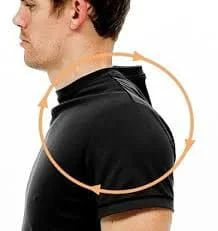
- When beginning trapezius stretches, shoulder rolls are a terrific way to loosen and warm up the muscles, which will increase the effectiveness of the stretches.
- Take a comfortable seat or stand with proper posture.
- In a circular motion, roll both shoulders up and down, then forward and up.
- Draw little circles initially, and gradually larger ones with time
- Do this for 30 to 60 seconds, then repeat the process in the other way.
Chin Tucks
- For those who experience neck or trapezius pain, chin tucks, also known as cervical retractions, are a need. They prevent a forward-poking-chin posture, help realign the neck, release tension from the upper traps, and loosen the joints in the upper back and lower neck.
- Sit or stand with proper posture, sitting up.
- Without cocking your head, slowly bring your chin up to your neck.
- Make sure you are using the proper technique by visualizing your chin resting on a shelf and sliding it along the shelf. You ought to feel as though you are putting a double chin on yourself.
- After three seconds of holding, let go. Repeat ten to fifteen times.
Upper Trap Side Bends
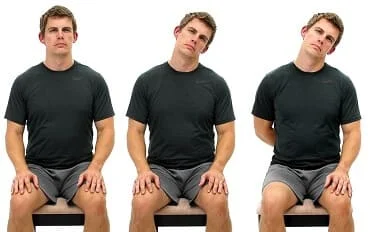
- One of the finest upper trapezius exercises to begin with when trying to release chronically tight trapezius muscles is side bends. They are effective in relieving knots and trigger points in the trapezius muscle and can be adjusted to target different areas of the muscle. When doing these head tilts, you should begin slowly and avoid stretching yourself too much too soon to avoid creating neck pain.
- In a chair, sit up straight and with proper posture.
- With your ear pointing toward your shoulder, cock your head to one side.
- Throughout, keep your nose and eyes directed ahead.
- Hold for three seconds, then take a step back to begin.
- Strive for ten to fifteen repetitions on each side as you repeat.
Upper Trap Head Tilts
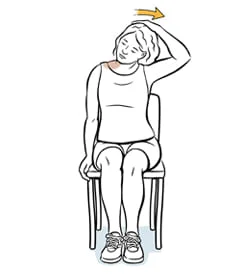
- For deeper strains of the upper trapezius, head tilts are the next step up from side bends. Once more, start carefully to avoid aggravating any trapezius or neck problems.
- Maintain proper posture when sitting up straight and grasp the chair’s bottom with one hand.
- With your ear toward your shoulder, tilt your head to the other side.
- Grasping the chair’s bottom to stabilize your shoulder can help extend your trapezius.
Middle Trapezius Stretch
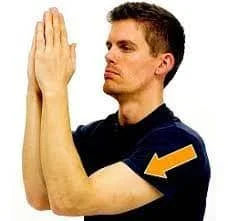
- You may adjust this middle trapezius stretch to lengthen it even more when your muscles relax. It’s a terrific way to stretch both sides at once.
- With proper posture, sit or stand.
- Put your forearms and hands together as indicated.
- Till your upper back starts to expand, bring your shoulders and shoulder blades forward.
- Hold for 15 to 30 seconds, then do so three times.
Sideways Child’s Pose
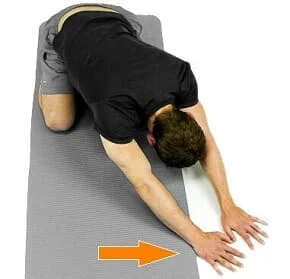
- This variation of the yoga child’s pose is a great way to stretch your upper back and trapezius muscles.
- With hands beneath shoulders and knees beneath feet, drop to all fours.
- Reposition your buttocks slowly while allowing your torso to touch the ground.
- To release the tightness in your trapezius muscle, slowly slide or stroll your hands out to the side while maintaining the position.
- After 30 seconds of holding, move your hands to the opposite side and repeat.
- Go back to the beginning position and repeat each method two or three times.
Massage Ball Stretches
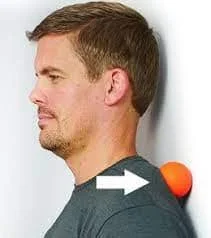
- Place the ball behind your back, over the trapezius knot or tight area, while standing with your back to the wall.
- To extend your trapezius, lean back against the ball and apply light pressure.
- Hold the pressure for 30 to 60 seconds if the trapezius muscle is knotted.
- Roll the ball in small circles or up and down for one to two minutes if the trapezius is chronically tight.
Eagle arm stretch
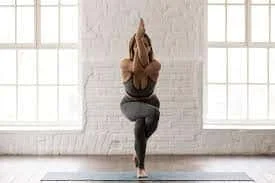
- Your feet should be hip-width apart as you stand.
- As you inhale, raise your arms to the sides.
- Swing the arms inward toward the torso as you exhale.
- Next, permit the right arm to pass beneath the left arm.
- Place the left elbow joint in the right elbow joint’s crook.
- To make them reach for one another, begin the palms together.
- Hold the backs of the hands together when the palms are not in contact.
- After that, inhale deeply three or four times.
- Release the stretch and do it again, crossing the left arm beneath the right.
- Perform this stretching exercise three times in a single session and three times daily.
Standing wall trap stretch
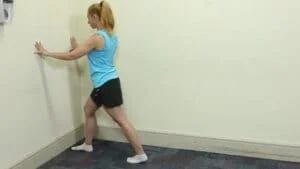
- Position both hands at a 90-degree angle to your torso on a wall.
- Next Step back with your feet until your arms are bent and straight, bending forward at the hip joint.
- However, tend to this matter. Avoid pushing against the wall to prevent shoulder impingement, and don’t elevate your arms too high.
- Avoid hunching your shoulder joint around your neck and maintain a backward posture.
- Perform this stretching exercise three times in a single session and three times daily.
Ear-to-shoulder stretch
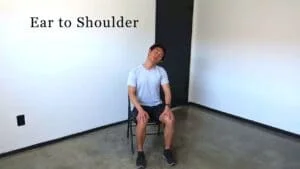
Maintain a straight back while sitting, and turn your head to face your right shoulder.
Next, extend your range of motion without exerting undue strain on your left shoulder joint.
For Gently bring your head down with your right hand to deepen the stretch.
For thirty seconds, maintain this elongated posture.
Perform this stretching exercise three times in a single session and three times daily.
Strengthening Exercises
Barbell Shrug
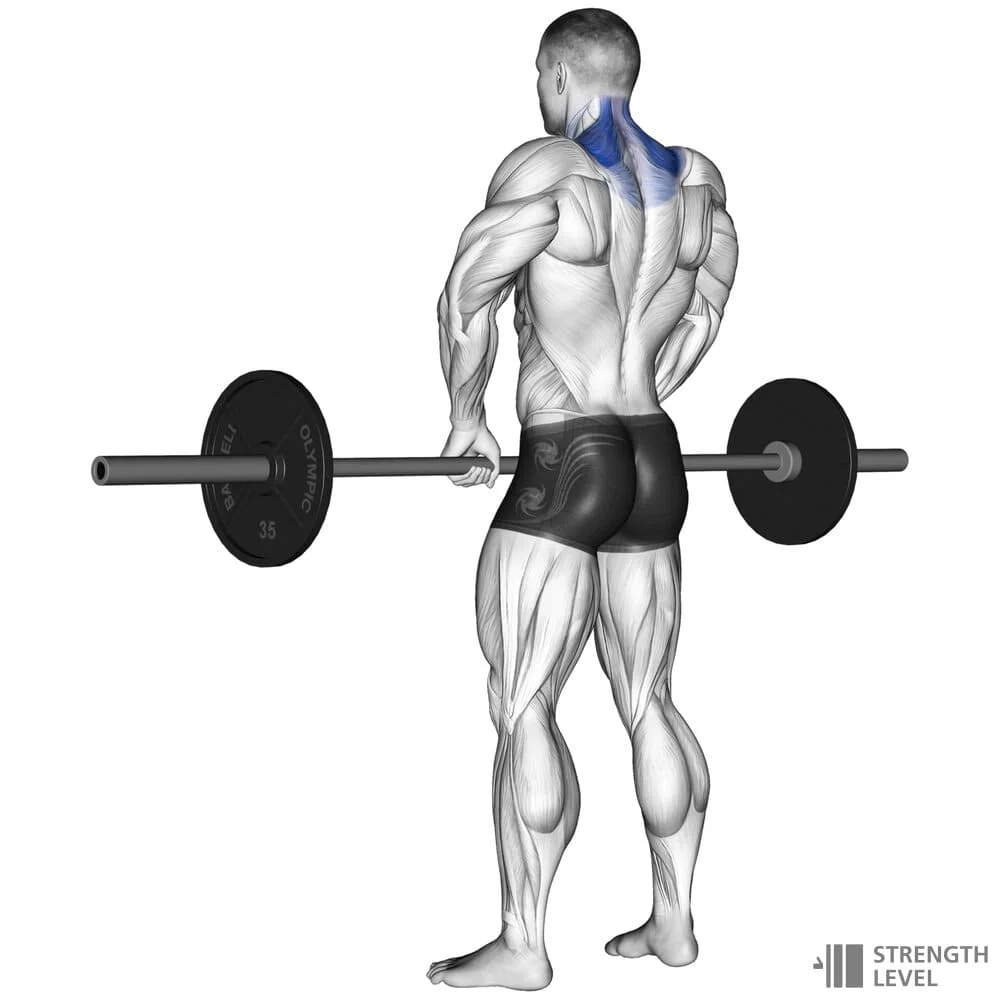
- A fundamental exercise that works the trapezius muscle is the barbell shrug.
- Start by placing a barbell in front of you and placing your feet shoulder-width apart.
- With your hands shoulder-width apart, hold the barbell in front of you at arm’s length.
- Raise your shoulders as high as you can while maintaining a straight back, lowered shoulders, and an engaged core.
- After a two-count pause, carefully return them to the starting position.
- Perform ten to twelve repetitions.
Dumbbell Lateral Raise
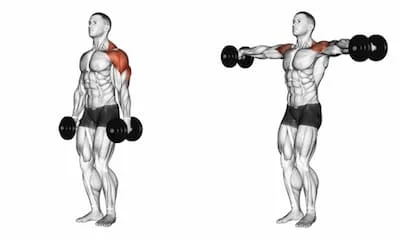
- One popular shoulder exercise that works mainly on the middle deltoid muscle is the lateral rise.
- Start by placing a dumbbell in each hand and standing with your feet shoulder-width apart.
- With your hands toward your thighs, hold the dumbbells at arm’s length at your sides.
- Raise your arms out to the sides until they are parallel to the ground while maintaining a straight back and a tight core.
- After a two-count pause, carefully return them to the starting position.
- Perform ten to twelve repetitions.
Pull-Up
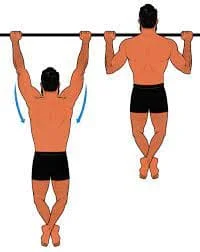
- Take hold of the pull-up bar using both hands. The arms should be apart by little more than the width of the shoulder, with the palms facing away from the body. Make sure that in the first position, the arms are fully extended.
- Raise your chin slightly above the bar by pulling yourself upward. Remember that during the entire workout, the upper torso should remain motionless.
- After a brief moment of holding, go back to the starting posture.
- Do the workout as many times as is prescribed.
Cable Face Pull
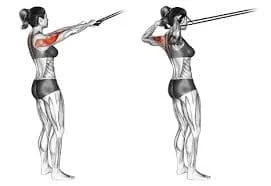
- Use this underappreciated trapezius maneuver to include the face in the movement.
- If the patient is focused on perfecting the technique to help protect the back and shoulders, they can perform this exercise with the resistance band or even the cable machine. When performed correctly, the face pull targets the lower trapezius.
- The patient must position the resistance band or cable equipment at approximately eye level for this exercise.
- Using both hands in an underhanded hold, grasp the ends of the band or the handle of a cable rope. To draw toward the face, squeeze your shoulder blades together, keep your elbows raised, and fight the impulse to sag forward.
- When the patient pulls back as far as he can, stop and squeeze, then move the cable or even the bands back to the beginning position.
- Perform 2–3 sets of 10–15 repetitions in a single day.
Dumbbell Jump Shrug
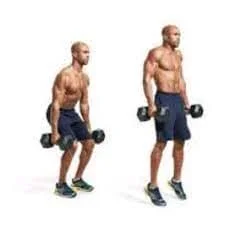
- The explosive motion gives the everyday workout more strength. The objective should be to complete each repetition as fast as possible while always controlling the weight.
- Dumbbells should be held in each hand, and the hips and knees should be bent. With the palms facing the sides, hold the dumbbell at arm’s length, slightly below the knees. Avoid hunching your lower back.
- As much as the patient can do, simultaneously drive the hips forward, shrug the shoulders firmly, and leap. Repeat after landing as softly as you can.
- Perform 10 to 20 repetitions of this in a single set each session.
Barbell Row
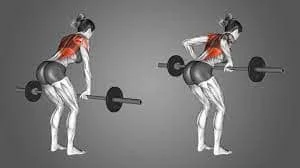
- The muscles that help prevent the shoulder blades from shifting while the patient raises the barbell are targeted by rowing exercises: the middle and lower trapezius and rhomboids.
- This is significant because weak shoulders might restrict the strength of arm and chest movements. The rotator cuff, posterior deltoids, and upper trapezius muscles will aid the rowing motion.
- Grasp a barbell at arm’s length using an overhand grip that extends slightly beyond the shoulder width. Lower the trunk until it is nearly parallel to the floor, flexing the hips and knees. The natural arch of the back is desirable.
- Carefully drop the barbell back to the embarking position after holding it for two to four seconds.
- Perform two to three sets of 10 to 20 repetitions in a single session.
Prone rowing exercise
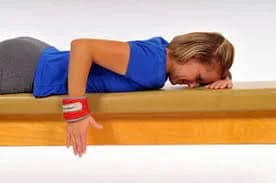
- reclines on your bed, arms swinging loosely over the edge.
- Raise the arm against the floor and bend at the elbow while maintaining the “set” position of the shoulder blades.
- Raise your elbows and sideways till your hands come into contact with your lower ribs.
- Always take a leisurely step back to the beginning.
- Perform ten to fifteen repetitions in two sets.
Reverse prayer pose exercise
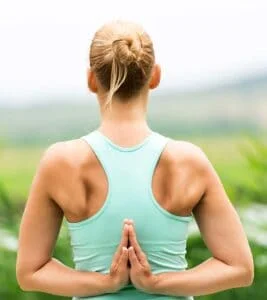
- You are striking this stance in three different positions: sitting, standing, and tree pose.
Then begin this exercise with your hands behind your back, fingers pointing downward, and the backs of your hands facing each other.
With your fingers pointing up, oppositely flip your hands from this posture. - After that, turn your palms toward one another.
Bring your elbow joint slightly back, press your palms together, and open your chest.
You have to maintain a straight spine.
Once in position, hold it for ten seconds.
Ten times in a single session and three times a day, repeat this workout.
Arm circles exercise
With your feet shoulder-width apart and your arms straight down your sides, you are standing erect.
Next, Make large circular movements with your arms as you advance.
Need to Make sure your arms remain straight.
Once you’ve completed a few repetitions, change your direction and move your arms backward in a circle.
Do this workout three times a day and ten times in a single session.
Standing arm swings exercise
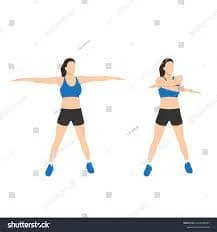
With your palms facing your body and your arms by your sides, you are standing.
Next, Raise your arms to their maximum height without elevating your shoulder joint by swinging your arms forward.
Bring the arms back as far as you can and lower them again.
Don’t move the rest of your body.
Keep up this motion for a minute.
Summary
Large and trapezoid in shape, the trapezius muscle is located in your neck, back, and shoulders.
It supports proper posture maintenance, neck rotation, and tilt, retraction of the shoulder blades, and spine stability.
The spinal accessory nerve can be damaged, which could result in trapezius muscle weakness.
Muscle spasms and strains are also possible. Most of the time, stretching, moist heat, and ice will assist you get rid of your problems.
Acupuncture, massage, and physical therapy are more options.
FAQ
Is the trapezius a neck or back muscle?
One of your back’s main muscles is the trapezius. It travels down to the middle of your back from the base of your neck, across your shoulders, and down. They call it the trapezius due to its shape.
How painful is the trapezius muscle?
The muscles of the trapezius control numerous actions of the arms and shoulders. It is mostly utilized for throwing, although it can also be used for head and neck movement. It is mostly utilized for throwing, although it can also be used for head and neck movement. You may experience mild to severe pain in your neck, shoulders, or upper back if you have a strained or “pulled” trapezius muscle.
What are examples of trapezius?
An overhead press is an illustration of the trapezius function. Along with other muscles like the rhomboids, the upper and lower fibers help the middle fibers with scapular retraction/adduction when they activate simultaneously.
Why are my trapezius muscles so big?
Long-term strain will cause the trapezius muscle to grow larger and stronger, which will result in a thicker shoulder. The use of the trapezius muscles can be impacted by a variety of factors, including improper posture, breathing patterns, and walking or movement posture.
What is the best exercise for big traps?
If you’re not already doing them, it’s time to give upright rows a try. They’re a terrific exercise to add to your program for working up your trap muscles. They will not only help you increase the size and strength of your traps, but they will also work your anterior and rear deltoids.
What is the main function of the trapezius?
It forms a trapezoid shape, beginning at the back of your head and neck and extending across your shoulders and down the middle of your back. The trapezius muscles, sometimes referred to as “traps,” are crucial for proper posture. 1. They protect the neck and spine, shift the shoulders, and raise the arms to the sides.
Does massage help trapezius pain?
It has been demonstrated that massage helps the afflicted areas move more freely and less painfully when it comes to trapezius strain. Furthermore, massage promotes relaxation, which lowers stress levels and releases tension stored in the trapezius muscle region.
How do you heal your trapezius?
Rest: Reduce the use of the afflicted muscles
Ice: for muscular edema reduction
Compression: A technique to lessen muscle edema.
Anti-inflammatory drugs: help lessen muscle soreness and swelling.
Physical Therapy: To help the healing trap muscles regain their strength and range of motion.
What is trapezius nerve damage?
A spinal accessory nerve damage causes trapezius palsy. Pain, winging of the scapula, and loss of shoulder abduction are the symptoms of the disorder. The quality of life and functional results of surgery may both be enhanced.
With pain in my neck and trapezius, how should I sleep?
It’s especially advised for the back; just use a pillow that supports your neck’s natural curve and a flatter pillow for your head. Use a taller pillow under your neck if you sleep on your side so that your neck and head are in alignment.
What are the three trapezius muscles?
The trapezius is composed of three functional parts: the middle area, called the transverse portion, retracts the scapula; the lower section called the ascending part, medially rotates and depresses the scapula; and finally, the upper part, which bears the arm’s weight.
How do you strengthen your trapezius?
Deadlifting. The deadlift will put a lot of strain on your middle and upper trapezius muscle fibers.
Shrugs off. When many individuals think about upper trap training, shrugs are probably one of the first exercises that come to mind.
Barbell Row.
Reverse Dumbbell Flyes.
Pull-Up.
Lat-Pulldown.
What are the benefits of strong trapezius?
The traps are crucial for preventing injuries as well. Robust traps not only protect the neck during contact but also effectively absorb hits to the shoulder area, lowering the risk of neck injuries and even concussions. Try these workouts for larger, more powerful traps.

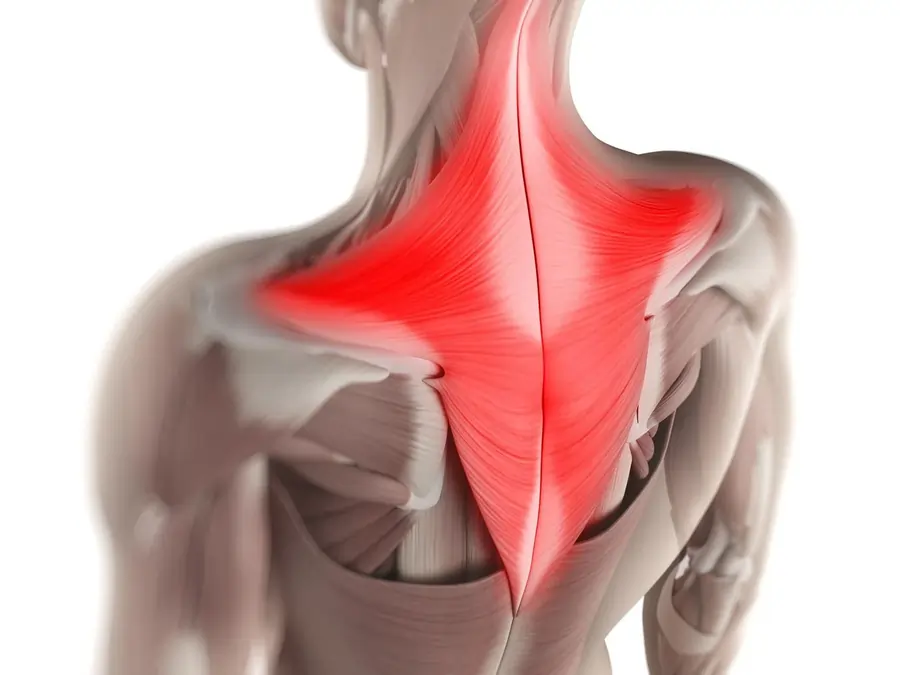
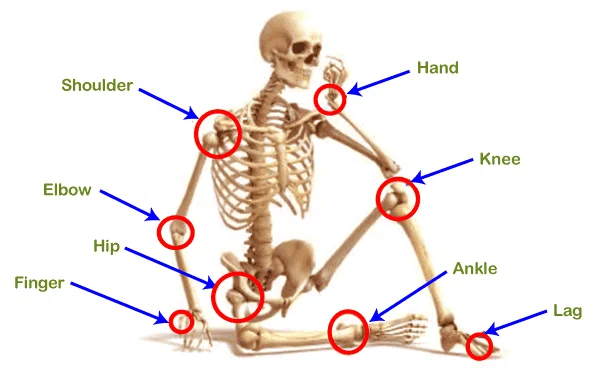
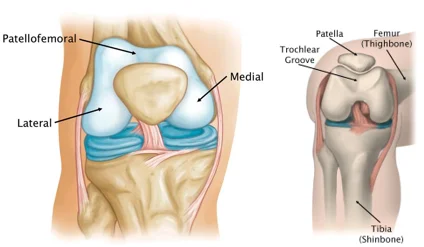
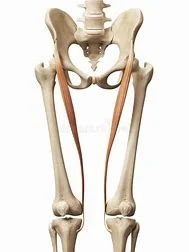
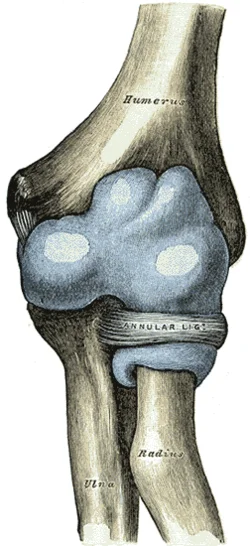

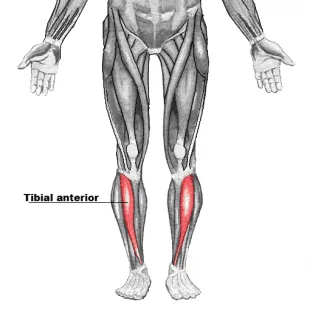
14 Comments